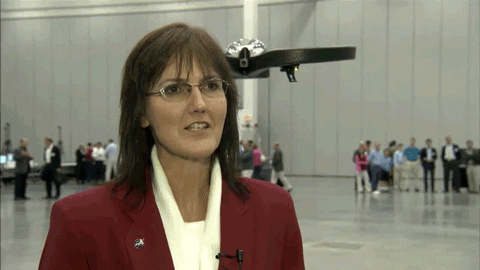Drones. If you had to pick a sector to sink your money into with the knowledge that you couldn’t touch it for ten years, drones would be up there as a good bet.
Turns out, two thirds of everything we send through delivery systems currently weighs less than 2.2lbs, or 1 kilogram. This makes a whole whack of stuff very drone-able.
But how quickly can it happen?
A few years back, drive-sharing wasn’t a thing, but our desire to get around quickly and cheaply, or get our stuff moved around quickly and cheaply, essentially uoended the taxi industry in a heartbeat.
Drones take that to the next level. Along with self-driving cars, they’re reflective of the fact that we’re lazy as a species. Let me hit a button, but then leave me alone until my package is here.
AltaVista (AVV.V) is a mining stock that has decided not to mine anymore and, instead, change business to the Unmanned Automated Vehicle (UAV) sector.
As part of that plan, it’s laid out a series of companies it wants to acquire. Namely:
- High Eye, a UAV surveying company, for 2,200,000 shares of Alta Vista and $200,000
- Aeromao, a UAV manufacturer, for $1,400,000 and 2,200,000 shares of Alta Vista
- The UAV division of Pioneer, developer of the world’s first UAV-based magnetometer, for 9,000,000 shares of Alta Vista and $500,000, plus 10% royalty on profits for 5 years.
Basically, for $2m and 13.4m shares and AltaVista is a fully working resource exploration drone outfit. Not a bad launch.
In Canada, only one other outfit has pushed into the drone market on the public exchanges, and that’s Drone Delivery Canada (FLT.V).
While AltaVista wants to run magnetometers across cow pasture to see if there’s any shiny underneath, DDC wants to run groceries to your door, whether you live downtown or in, say, Nunavut.
It’s no secret that people who live in Canada’s northern communities get well screwed over on the cost of their groceries, because the vast majority have to be shipped (or, rather, flown) from the southern strip of the country.
DDC thinks it can help on that front, and thinks the Canadian government will be well inspired to help. They may be right.
In the short term, the company says it has a bunch of MOUs with Canadian retailers to run tests and to develop commercially viable hardware and software, but sees its real value right now as being a company – the only company – actively addressing the Canadian government on how to make this service a reality.
I’ve interviewed the CEO of the company for an upcoming podcast and will release that next week, and it’s an interesting talk.
Adding to the buzz, stock promoter extraordinaire Richard Buzbuzian was behind the shell it rolled into (I call it a shell but actually it was the resource-bereft Asher Resources that simply ran out of juice and jumped at a chance to be something relevant again).
Who else is in drones? Well, it’s a bit of a mixed bag.
Drone Aviation Corp (OTC:DRNE) has managed to lose around 80% of its value since 2014. It’s management team came from Lighter Than Air Systems, which was sold to World Surveillance Group a few years back and managed to join that company in a 99% crash.
Matternet is in the drone delivery business down south and has a product it says could cover a city with 150 drones for $900,000, or $1000 per drone per month. Problem: The drones can only travel 12 miles. Their solution? Smattering the city with recharging stations… eh… Also, Matternet isn’t public.
Delta Drone (EPA:ALDR) trades in Europe and hasn’t caught on yet. AgEagle has, and has a sales deal with Raven Industries (NASDAQ:RAVN) to help farmers figure out what crops need help. AeroVironment (NASDAQ:AVAV) is a nice option, as it provides most US military drones. DJI Innovations has a big chunk of market share, but is a Chinese private firm. Then there’s ground drone startup Starship Technologies, which will run little robots through traffic, it says.
None of this makes sense as an investment, really. There’s either no value left in companies with big market share, or many barriers to market.
But those two Canadian options are interesting. Both are low on the market cap side, both are playing in markets largely untapped as the US space gets flooded. And both are working in a country with unique needs – in AltaVista’s case, the need to get mining properties well explored, and in Drone Delivery Canada’s, the need to keep people fed, medicined, and reachable in harsh conditions.
I prefer the latter, and here’s why: The big problem with using drones to explore resource property is one that, without government intervention, is a complete game ender. Most exploration currently comes at a cost, but the continued use of the property being explored is usually based on a certain amount of money being put to the property.
It costs to fly over in a plane, or a chopper, or send a geo up a rock face. It costs to drill. And while those costs are being employed, the property doesn’t revert to the government, or an original owner.
But drone exploration costs next to nothing. So in order for it to happen, it has to happen as well as the traditional exploration costs.
Which isn’t to say it won’t happen, or that rules won’t change (they should). But it doesn’t work now.
Neither, frankly, do Drone Deliveries plans to send their machines hundreds of miles.
But a quick trip from Canadian Tire to deliver me a new softball glove? Yeah, that’s doable right now.
Stay tuned.
–Chris Parry
http://www.twitter.com/chrisparry

